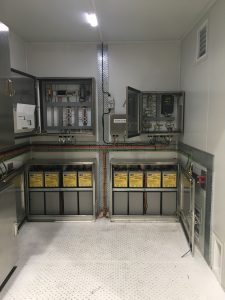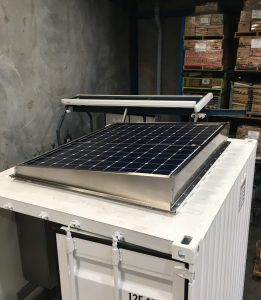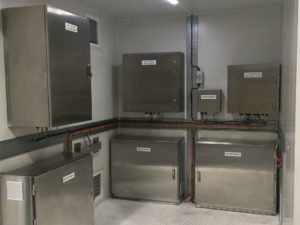Problem / Demand / Purpose
Supply power to a production site located in the Southern Highlands of Papua New Guinea for production wellhead monitoring and control instrumentation with a design emphasis on simplicity, ease of operation, mobility and also protection against extreme environmental conditions such as humidity and earthquake, harsh weather elements and vandalism / theft.
Solution
Skid based stand-alone photovoltaic (PV) solar power system consisting of
- 2 x 350 W photovoltaic solar arrays with integral support structure,
- System charge controller / solar regulator,
- 12 off 908 Ah batteries connected in a 24 VDC configuration with suitable protection and isolation,
- A weather proof 50A, 24 VDC Anderson socket connected to the batteries to allow a portable battery charger to be connected if the maximum number of no sun days is exceeded.
- A temperature sensor(s) fitted in the middle of the battery bank for connection to the solar regulator for temperature compensation
- Load distribution system,
- RTU control panel,
- Mechanical support
and contained within a ventilated, vandal-proofed single shipping container which has electrical, structural and mechanical design and installation arrangement complaint to the most recent requirements, rules in relevant AS/NZS Regulations / Standards together with the client’s design specifications.
Result
A SOLAR CUBE container internally lined with a non-combustible material is fully designed and supplied by Indratel with the specifications such as
- It is suitable to be used as 24 VDC power sources to support an automated well pad control panel as per Electrical load list provided by the client.
- It only uses 24 VDC equipment to minimise the use of voltage converters.
- Solar arrays are sloped at a certain angle to facilitate water runoff with a special mounting brackets fitted to the Solar Cube container roof meeting the anticipated wind loads with a non-lowerable (i.e. no cut-outs) arrangement on the container roof and secured with angle iron bolted to a frame with tamper-proof bolts designed to prevent access to cabling and removal of the solar arrays without special tools without any impact on the potential output of solar panels through the introduction of shading.
- Batteries securely mounted in an enclosure with an adequate natural ventilation of hydrogen that is evolved when charging with a provision made for the containment for any spilled battery electrolyte to the container floor.
- Battery enclosure is in a position which is easily accessible for maintenance and replacement in an ergonomic manner to allow for ease of replacement while accommodating 12 batteries inside.
- The supporting surface of the Solar Cube has adequate structural strength to support the weight of all installed equipment and their support structures can withstand long journeys on rough, unmade roads
- The container can be easily loaded and unloaded on transport vehicles with a size / volume allows for sufficient clearance around installed equipment to provide access for installation and maintenance with an unobstructed exit, and include appropriate means to prevent access by unauthorized persons
- The external surface of the solar container is protected by thermal insulating paint and then special internal lining on the container roof and all walls including doors is installed in such a way to not reduce the strength/ bond of the mounting brackets for each cabinet mounted on the container walls.
- Adequate lighting controlled by a door proximity switch is installed within the solar enclosure / container to facilitate maintenance and operation.
- All power distribution is 24 VDC and supplied by individual double pole DC circuit breakers or fused terminals sized to protect the associated field cable from overload and short circuit faults with fused supplies for internal circuits and field supplies and Individual fused terminals provided on the positive and common for each supply.
- Battery ventilation meets the requirements outlined in relevant AS/NZS standards and Container ventilation ensures that internal temperature within the container does not exceed 45°C based upon the maximum heat output of all internal equipment at the maximum ambient temperature, 30 Deg C.


